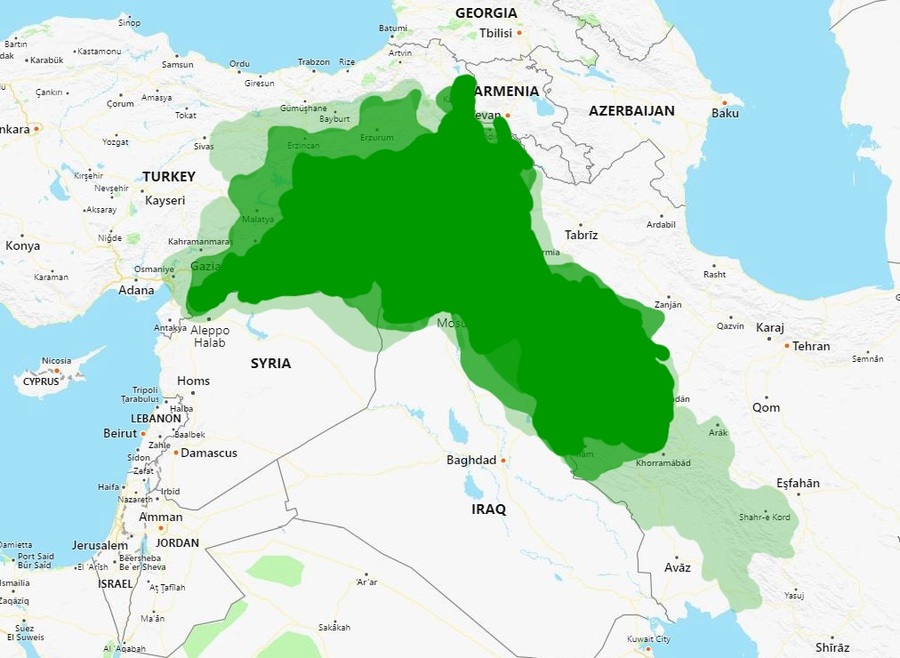Human geography investigates human beings and their societies on the surface of the Earth, how they developed and spread, how they inhabited and maintained their economic activities, and how they adapted to natural environments such as water, air, heights, and plains on Earth.
Human geography is a very broad field and consists of a wide range of subdisciplines.
The Natural Growth of the Population
1. Childbirth
2. Death
Due to several factors such as the majority of women having children, the deaths of a large number of people due to war and such problems, lack of birth and death data in remote villages, hiding the real statistics by countries occupying Kurdistan and some other factors, the accurate statistics and data on births and deaths in Great Kurdistan are not available.
Despite this, however, the rate of birth and death in Great Kurdistan was estimated as follows in 1985:
Birth
The Great Kurdistan 0.48%
Turkey 0.28%
Iran 0.42%
Iraq 0.43%
Syria 0.44%
The birth rate in Kurdistan is due to some economic, social, and political reasons:
1. Marriage at an early age.
2. Having a bright future.
3. Religious reasons.
4. High rate of giving birth among the females.
5. Developing families.
Death
The death rate in the Great Kurdistan reached 0.27% in 1985 which was a high number compared to the neighboring countries. This is due to these factors:
1. War
2. Biological death
3. Anfal and chemical attacks
4. Diet
5. High rate of death among newly born babies
The national structure of Kurdistan
Kurdish, Turkish, Arab, Assyrian, Kildan, Syrian, Armenian, Turkmen, and Persians live in the Great Kurdistan.
The reasons for other nations living in the Great Kurdistan are as follows:
1. The geographical location of Kurdistan
2. Attempts to genocide Kurds and reduce their population
3. Migration of most of these nations to Kurdistan regions
4. Domination
Despite this in 1985, the percentage of Kurds in Kurdish cities was higher than in any other nation, with 69% of the population in the Great Kurdistan being Kurdish citizens; this percentage was much higher in large cities like:
1. Suleimani 94%
2. Kermashan 83%
3. Van 71%
4. Erbil 86%
5. Diyarbakir 71%
Religious Structure
1. Zoroastrianism: originated centuries before Christianity and is considered to be the oldest religion in Kurdistan. Zarathustra began his life at the age of thirty.
2. Jewism: a large number of Jewish people who practice Theology have lived in Kurdistan for a long time. The majority of these people went to Israel or European and American countries during the last century.
3. Christianity: this religion is vastly spread in Kurdistan beginning from Duhok Province to Ninewa Plain, Erbil Plain, Shaqlawa, Koya, Kirkuk, and Suleimani. Christian citizens nationally belong to Kildani, Assyrian, Syrian, and religiously belong to Orthodox Christianity and they all live in Kurdistan.
4. Islam: the beginning of this religion in Kurdistan goes back to the year 637 AD and most of the Great Kurdistan citizens are followers of this religion which has two main sects, Sunni and Shia. Each of these two sects was divided into several branches. The Sunnis of Kurdistan mostly belong to the Shafi'i branch and the Shia are mostly following Twelve Imams' beliefs.
5. Yazidi: the followers of this religion are Kurds nationally and they live in the North, South, and West parts of the Great Kurdistan and some of them live in Armenia and the Former Soviet Union countries.
6. Yarsan: it is a completely Kurdish religion and it dates back to the ancient religions of Kurdistan. It was rebuilt by Sultan Sahak in the 13th century. Most of the followers of this religion that their number reached more than two million people live in the East part of Kurdistan, especially in Kermashan Province. The Kakaeis of the Southern part of Kurdistan are considered to have the same religion as the Yarsans.
What is the reason for the large population density in Great Kurdistan?
1. The strategic and geographical location of the Great Kurdistan
2. Natural benefits and the numerous resources such as mines
3. The density of population due to political reasons
4. Establishment of military headquarters
Urbanization and Rural residents
The number of citizens in the cities has increased largely in the recent century. It is due to:
1. Constant migration of villagers to the cities to find occupation opportunities more easily and services in the cities.
2. Maintaining the natural increase in population
3. Migration of foreigners into the Great Kurdistan cities
4. Changing some of the large gatherings of residents from village to city.
Agricultural activities in the Great Kurdistan
There is a vast land in the Great Kurdistan that is very fertile for agriculture. This land's area is about 214 million and 400 thousand dunams (53 million and 600 thousand hectares). That is 36% of the land in the Great Kurdistan is used for planting and agriculture.
The Types of Agricultural Products in the Great Kurdistan:
1. Farm productions
2. Fruits and gardening
3. Vegetables
4. Wild herbs
The economic activities in the Great Kurdistan
These activities are seen in the fields of industry, tourism, agriculture, roads, and many other aspects that explain the main basis of national income and economic activities in the Great Kurdistan.









